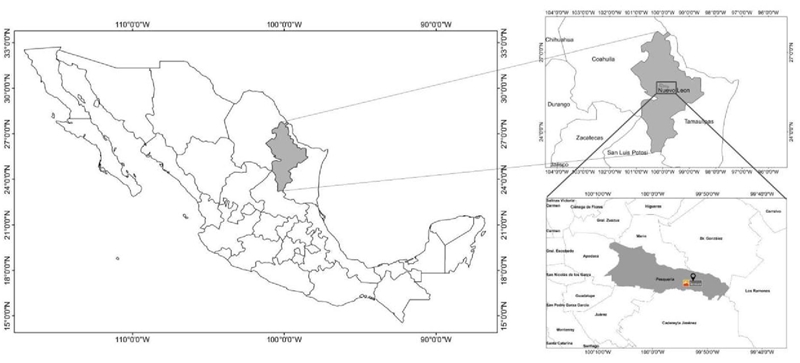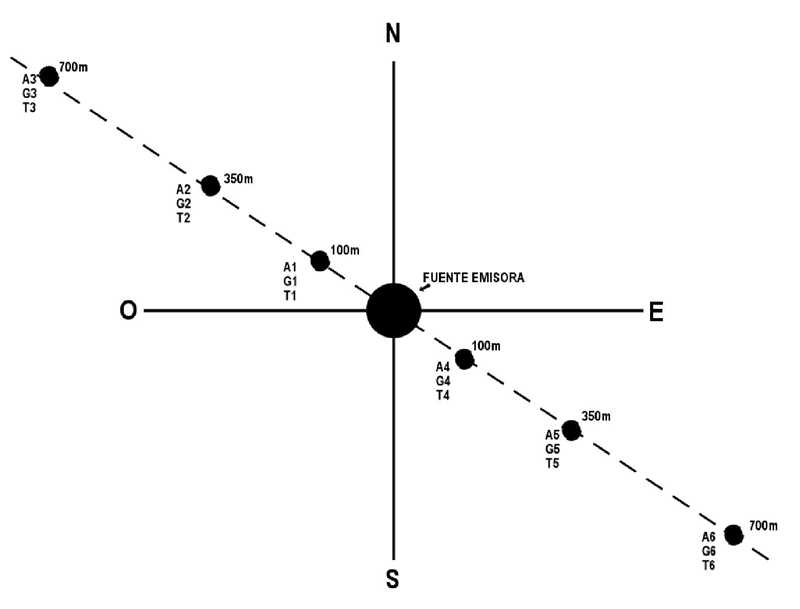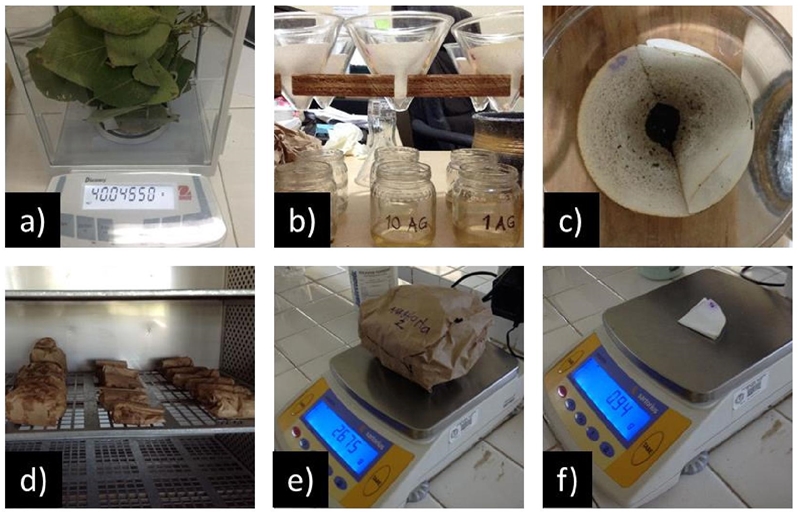Serviços Personalizados
Journal
Artigo
Indicadores
-
 Citado por SciELO
Citado por SciELO -
 Acessos
Acessos
Links relacionados
-
 Similares em
SciELO
Similares em
SciELO
Compartilhar
Revista mexicana de ciencias agrícolas
versão impressa ISSN 2007-0934
Rev. Mex. Cienc. Agríc vol.10 no.1 Texcoco Jan./Fev. 2019
https://doi.org/10.29312/remexca.v10i1.1545
Investigation note
Analysis of suspended particles deposited on arboreal vegetation in northeastern Mexico
1Escuela Técnica Superior de Ingenieros en Montes-Universidad Politécnica de Madrid. Ciudad Universitaria s/n, Madrid, España. CP. 28040. Tel. 00(34) 8212121788. (mikepequeno@hotmail.com).
2Facultad de Ciencias Forestales-UANL. Carretera Linares-Cd. Victoria km 145, Linares, NL, México. CP. 67700. Tel. (01) 8212124251. (eduardoforestal@gmail.com; oaguirre16@gmail.com).
3RENAC, SA. De CV. Corregidora 102 Nte, Col. Centro, Linares, NL. CP. 67700, Tel. (01) 8211192870 (vmmolinaguerra@hotmail.com).
4Unidad Académica en Desarrollo Sustentable-UAG. Carretera Nacional Acapulco-Zihuatanejo km 106+700, Técpan de Galeana, Guerrero. CP 40911. Tel. 01(742) 1069958. (xtemoc@hotmail.com).
5CEVAMEX-INIFAP. Carretera los Reyes-Texcoco km 13.5, Coatlinchán, Texcoco, Estado de México. CP. 56250. Tel. 01(595) 9212657.
6Faculty of Agriculture-Kyoto University. Kitashirakawa Oiwake-cho, Sakyo-ku, Kyoto, Japan. 606-8502. Tel. 8211426009. (laura@kyudai.jp).
The activities of vegetation removal generate an impact on the suspension of sedimentary particulate material. The study of the impact of these particles in areas close to the removal works allows a first approximation of a quantitative nature for environmental impact studies in areas where there are no records of the degree of affectation. The objectives were to evaluate the impact on the time elapsed between the distance of the emission zone and the direction of the wind with respect to the concentration of particulate material in the vegetation adjacent to the area altered by the removal work. The concentration of suspended particles deposited on adjacent tree vegetation during 2014 and 2015 was analyzed. 18 trees of three different species (Cordia boissieri, Acacia amentacea, Havardia pallens) were sampled at distances of 100, 350 and 700 m in northwest and southeast directions from the area of vegetation removal. The amount of sedimentable particulate material was determined in relation to the foliar dry matter. In the samplings of May 2014 and February 2015 there were no significant differences, while for September 2015 there was a difference, with the southeast address showing the highest amount of particulate sediment. It is concluded that the analyzed material is inversely proportional to the elapsed time of the removal of vegetation, and a greater sediment concentration is observed in the direction of the prevailing winds.
Keywords: dust; vegetation removal; wind direction
Las actividades de remoción de vegetación generan un impacto en la suspensión de material particulado sedimentable. El estudio del impacto de estas partículas en zonas cercanas a los trabajos de remoción permite una primera aproximación de carácter cuantitativa para estudios de impacto ambiental en áreas donde no existen registros de afectación. Los objetivos fueron evaluar el impacto en el tiempo trascurrido entre la distancia de la zona de emisión y el rumbo del viento con respecto a la concentración de material particulado en la vegetación aledaña a la zona alterada por los trabajos de remoción. Se analizó la concentración de partículas en suspensión depositadas sobre la vegetación arbórea aledaña durante 2014 y 2015. Se muestrearon 18 árboles de tres especies (Cordia boissieri, Acacia amentacea, Havardia pallens) a distancias de 100, 350 y 700 m en direcciones noroeste y sureste desde el área de remoción de vegetación. Se determinó la cantidad de material particulado sedimentable en relación con la materia seca foliar. En los muestreos de mayo 2014 y febrero 2015 no hubo diferencias significativas, mientras que en septiembre de 2015 se presentó diferencias, la dirección sureste tuvo mayor cantidad de material particulado sedimentado. Se concluye, que el material analizado es inversamente proporcional al tiempo trascurrido de remoción de la vegetación y se observa mayor concentración de sedimentos en dirección a los vientos dominantes.
Palabras clave dirección del viento; polvo; remoción de vegetación
The continuous growth of the cities contributes to the increase of the particles in suspension present in the atmosphere, which constitute a form of environmental pollution of a complex nature both for its chemical composition and its size. The main air pollutants are the total suspended particles, nitrogen oxides, carbon monoxide, sulfur dioxide, hydrocarbons and surface ozone (Pulifato et al., 1995).
The particulate material consists of solid or liquid particles suspended in the air, having a chemical composition and a size that varies from 0.005 to 100 μm in aerodynamic diameter (Sborato et al., 2007). Particles with diameters greater than 5 microns are notable for the deposit that is made, provided that the emission sources are low and the speed of the wind is high, but in case of smaller particles the deposit is lower. These macroparticles are trapped and filtered by the leaves and branches, which are washed by precipitation and drained to the ground where they are absorbed (SCFC, 1990). The amount of air pollutants increases when it comes to rural or mining-industrial areas, but the background, historical or indicative levels of the degree of contamination by particulate matter and sedimentary dust are unknown (Dalmasso et al., 1997).
Regarding the deposit of suspended particles on the vegetation, the size of them is an important and determining factor, since it affects or benefits in different ways depending on the type of vegetation present and the accumulated dust registers on the vegetation, which constitutes a tool to diagnose the degree of contamination and its distribution in the environment (Dalmasso et al., 1997). Air pollutants affect the process of photosynthesis of vegetation causing shrinkage in crops, and damage the materials of the facades of buildings, which results in large economic losses each year (Vollenweider and Günthardt, 2005).
Conversely, vegetation foliage conditions can play a role as a receiver of atmospheric dust and as a reference parameter on the differential degree of contamination. The use of arboreal and shrub vegetation, as well as its composition and structure of each of the plant individuals (mainly the leaves), contribute important lines of research in atmospheric dust studies (Kretinin and Selyanina, 2006; Acero and Simon, 2010).
In some countries, there are strict rules that require to surround the industrial zones with wooded strips or covered with vegetation, in this respect there are different studies to calculate the speed, size and distance of the suspended particles prone to sediment, in order to determine the size of the vegetation belt more effective for the control of those particles in suspension (Belot et al., 1976). Some authors show that the time elapsed after the cessation of activities that generate particulate material, the distance of the emission zone and the direction of the dominant wind, are factors that determine the amount of particulate material suspended and deposited in the vegetation (Calvo, 1996; Nuñez et al., 2005; Aragón et al., 2006; Girard and Girard, 2014).
For this reason, this study arises from the concern to quantify the impact generated in the environment as a result of the work of vegetation removal by the construction of a thermoelectric plant within a growing industrial park. The objectives of this investigation were: 1) to evaluate the effect of the elapsed time of the removal of vegetation in the concentration of particulate material on the surrounding vegetation; and 2) evaluate the effect between the distance of the area of emission of particulate material and the direction of the wind in the concentration of particulate material of the vegetation.
Study area
The study was carried out in the municipality of Pesquería, NL (Northeast of Mexico), in areas surrounding the Pesquería power station located between coordinates 25° 45’ 17.78” North latitude and 99° 58’ 01.40” West longitude, with an altitude of 300 m (Figure 1).
Data collection
In this research the methodology applied by Dalmasso et al. (1997), which considers the taking of samples along and starting from the emitting source (clearing zone) two transects depending on the prevailing winds, which in this case were those from the Northeast and Southeast (INEGI, 1989). According to the contiguous surface of the emission source with native vegetation in each transect, three measurement points were established: sector 1, at 100 m from the clearing zone, sector 2, at 350 m and sector 3, at 700 m, considering that there should be a gradient of decrease in contaminant levels in relation to the increase in distance from the source (Figure 2).
In each section, three species (Cordia boissieri, Acacia amentacea, Havardia pallens) representative of the Tamaulipas thorny scrub were evaluated, which present high value index values of importance (Pequeño et al. 2012; Donjuan et al., 2013; Alanís et al., 2016). Individual samples of leaves were taken from the side of the cups oriented towards the source, at a variable height between 1.5 and 2.5 m, for the ease of access (Dalmasso et al., 1997). The sample size was 40 grams, obtaining a total of 18 samples, result of the 18 points to be evaluated in each of the stages of this study (Astorga et al., 2011). The extracted material was conditioned in bags and taken to the laboratory for processing (Figure 3).
The extraction of the sedimentary particulate material (MPS) was carried out by washing, stirring periodically with distilled water and passing a small brush to favor the detachment of the particles. Glass beakers of 350 ml capacity were used. The extract obtained was filtered in a funnel through Whaltman filter paper No. 42 (previously tared), dried in an oven and the weight of the MPS was recorded. The leaves washed free of MPS, are being weighed, after drying in an oven at 75 °C until the constant weight was obtained (Figure 4). The data are expressed in grams of MPS per kg of dry matter of leaves (g kg-1).
Analysis of the information
Once the statistical assumptions of normality, homoscedasticity and independence between the values were verified, an analysis of variance (Anova) of one factor (p≤ 0.05) was performed. As a post hoc test the Tukey HSD test was used. The statistical program used was the SPSS version 19.0 (SPSS Inc., Chicago, IL, USA).
To determine the effect of the time elapsed from the removal of vegetation in the concentration of particulate material on the surrounding vegetation, Figure 5 was generated, where it is observed that the amount of dust registering if it presented difference over time (gl= 2; F=4.307, p= 0.019).
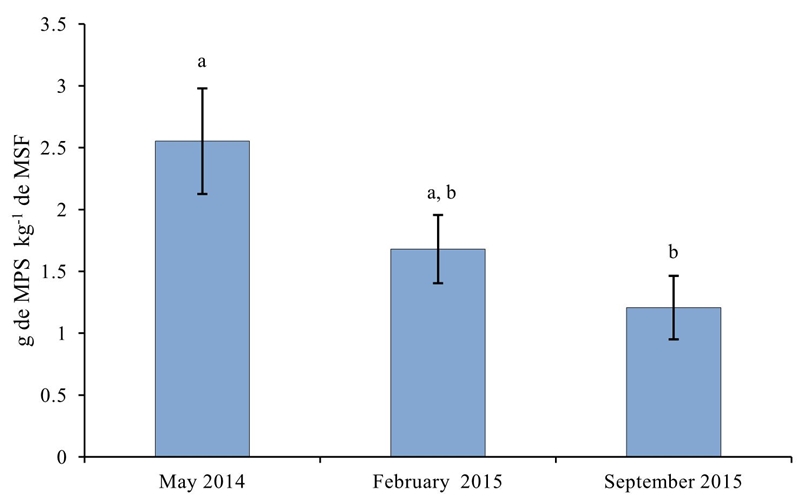
Figure 5 Concentration of sedimentable particulate material according to the sampling months. Average values ± standard error. Different letters (a, b, c) indicate significant difference (p< 0.05).
In Figure 5, a clear tendency is observed over time, decreasing the amount of sedimentary particulate material as time passes, which is directly related to the start and end of the vegetation removal work in the place. This result coincides with those recorded by Röösli et al. (2001), Celis et al. (2007) and Pachon and Vela (2014) who in their pollution studies by particulate material also recorded a direct relationship between the decrease of the same and stages with low and no intensity of anthropogenic activity, finding the smallest amounts of sedimentary particulate material in stages close to the cessation of these activities.
It was also evaluated if there was an effect between the distance of the zone of emission of particulate material and the direction of the dominant wind in the concentration of particulate material of the vegetation. In the samplings of May 2014 (gl= 5; F= 0.426, P= 0.822) and February 2015 (gl= 5; F= 0.719, p= 0.621) there were no significant differences in the amount of dust at different distances. A possible explanation for this would be related to the particle size, since it is possible that larger particles could be present during the samplings of May 2014 and February 2015, as a result of the impact of the work of clearing and removal of vegetation, while that for the month of September 2015, the impact was smaller, generating smaller particles.
Márguez et al. (2011) mention that the smaller the particles, the longer they remain in the air will be greater, due to their density and size, they also mention that this type of particles can be suspended for weeks, and can be transported over long distances. This information also coincides with the results of Corleto and Cortéz (2012), who mention that larger particles are deposited more quickly and closer to the source of emission, while medium-sized particles move further away and are deposited at some distance from the source of emission and smaller particles are transported by winds at greater distances.
In the evaluation carried out in September 2015, if there was a significant difference in the amount of dust in the different distances (gl= 5; F= 4.576, p= 0.014), as can be seen in Figure 6. In the sampling carried out in September 2015 the highest value in concentration of sedimentary particulate material in SE direction was registered at 700 m, followed by SE at 350 meters with 2.93 and 1.47 g of MPS kg-1 of MSF respectively. This is because there are prevailing winds coming from the northwest in that season of the year which disperse the smaller particles suspended in the environment transporting them long distances from the source.
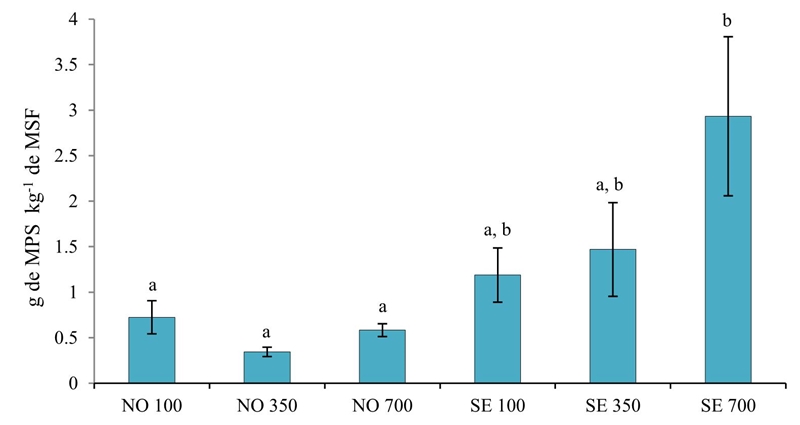
Figure 6 Concentration of sedimentary particulate material (MPS) by heading and distance for the September 2015 sampling. NO= northeast, SE= southeast and the values 100, 350 and 700 are the distances of the emitting source. Average values ± standard error. Different letters (a, b, c) indicate significant difference (p< 0.05).
These values are low compared to those recorded by Dalamasso et al. (1997), who in a similar study in an area where some cement industries are installed evaluated the total suspended particles deposited on the foliage of the adjacent arboreal vegetation composed of Acacia caven, Celtis tala, Eucaliptus camaldulensis, E. viminalis, Geoffroea decorticans, Prosopis alba, Prosopis nigra, Aspidosperma quebracho blanco and Schinus fasciculatus. They recorded maximum average values of 36.22 g of MPS kg-1 of MSF and minimum of 4.01 g of MPS kg-1 of MSF. This difference may be due to the morphology of the species they used for their study. What coincides with Beckett et al. (2000) who mention that the structure of the tree and specific variants such as leaf size, shape and texture of the leaf are factors that determine the ability to capture particulate material in each of the species. Granados and Mendoza (2002) indicate that the dust spread in open plantations tends to be larger and its presence varies according to the distance and origin of the particles. In addition, Codina et al. (2002) indicate that some characteristics of plant material such as foliage density, roughness of the foliage, presence of epidermal hairiness, as well as the interaction between the leaf surface and the surrounding air can be considered as factors in the retention capacity of the species.
Conclusions
Based on the results, it is concluded that the concentration of particulate material deposited in the surrounding vegetation is inversely proportional to the elapsed time of the removal of vegetation, causing a decrease in sediments as the time elapsed is greater. It is also concluded that the direction of the wind affects the concentration of particulate material of the vegetation, observing a greater concentration of sediments in the vegetation in the direction of prevailing winds and between a greater sediment concentration according to greater distance in the same direction of the prevailing winds with respect to the area of emission of particulate material.
Literatura citada
Acero, J. A. y Simón, A. 2010. Influence of vegetation scenarios on the local air quality of a city square. In: CLIMAQS Workshop ‘Local air quality and its interactions with vegetation’, Antwerp, Belgium. 21-22. [ Links ]
Alanís, E.; Molina, V. M.; Rechy, L.; Alcalá, A. G.; Marín, J. D.; Pequeño, M. A. 2016. Composición, diversidad y supervivencia de un área restaurada en el complejo siderúrgico de Ternium, Pesquería, Nuevo León. In: experiencias mexicanas en la restauración de los ecosistemas (Coord). Ceccon, E. y Martínez C. UNAM-Centro Regional de Investigaciones Multidisciplinarias-UAEM-CONABIO. Cuernavaca, Morelos, México. Capítulo 11. 255-272 pp. [ Links ]
Aragón, A.; Campos, A. A.; Leyva, R.; Hernández, M.; Miranda, N. y Lszczewski A. 2006. Influencia de emisiones industriales en el polvo atmosférico de San Luis Potosí. Revista Internacional de Contaminación Ambiental. 22(1):5-19. [ Links ]
Astorga, F. R.; Sosa, M.; Herrera, E. F.; Moreno, M. V.; Tena, M. y Campos, A. 2011. Pinus halepensis Mill: como indicador de contaminación atmosférica en una zona industrial urbana. Rev. Mex. Cienc. Forest. 2(7):79-86. [ Links ]
Beckett, P.; Freer, P. and Taylor, G. 2000. Effective tree species for local airquality management. Journal of Arboriculture. 26(1):12-19. [ Links ]
Belot, Y.; Baille, A. et Delmas, J. L., 1976. Modèle numérique de dispersion des polluants atmosphériques en présence de couverts végétaux: Application aux couverts forestiers, Atmos. Environ. 10:89-98. [ Links ]
Calvo, M. 1996. Ingeniería del medio ambiente. Colección Ingeniería del Medio Ambiente. Mundiprensa (Ed.). Madrid, España. 701 p. [ Links ]
Celis, J. E.; Morales, J. R.; Zaror, C. A. y Carvacho, O. F. 2007. Contaminación del aire atmosférico por material particulado en una ciudad intermedia: el caso de Chillán (Chile). Información tecnológica 18(3):49-58. DOI: 10.4067/S0718-07642007000300007. [ Links ]
Codina, R. A.; Fioretti, S. B.; Pérez, P. V.; Ureta, N. M.; Llera, C. J.; Verd, P.; Carrieri, S. A. y Manzano, E. R. 2002. Captación de polvo atmosférico por especies ornamentales. Rev. Fac. Cienc. Agrar., Univ. Nac. Cuyo. 34(2):73-79. [ Links ]
Corleto, A. M. y Cortéz, D. M. 2012. Comparación de los métodos de Bergerhoff y placas receptoras para la cuantificación de polvo atmosférico sedimentable. Tesis de Licenciatura. Facultad de Quimica y Farmacia. Universidad de El Salvador. El Salvador. 161 p. [ Links ]
Dalamasso, A.; Candia, R. y Llera J. 1997. La vegetación como indicadora de la contaminación por polvo atmosférico. Multequina. 6:91-97. [ Links ]
Donjuán, M. C. A.; Jiménez, J.; Alanís, E.; Camacho, R. A. E.; Yerena, J. I. y González, M. A. 2013. Efecto de la ganadería en la composición y diversidad arbórea y arbustiva del matorral espinoso tamaulipeco. Rev. Mex. Cienc. Forest. 4(17):124-137. [ Links ]
Girard, J. E. and Girard, J. 2014. Principles of environmental chemistry. Tercera edicion Jones & Bartlett Publishers. Massachusetts. EUA. 676 p. [ Links ]
Granados, D. S. y Mendoza, O. A. 2002. Los árboles y el ecosistema urbano. Universidad Autónoma de Chapingo (UACH). Dirección de Difusión Cultural. Texcoco, Estado de México. 96 p. [ Links ]
INEGI. 1986. Instituto Nacional de Estadística Geografía e informática. Síntesis geográfica del estado de Nuevo León. [ Links ]
Kretinin, V. M. and Selyanina, Z. M. 2006. Dust retention by tree shrub leaves and its accumulation in light chestnut soils under forest shelterbelts. Eurasian Soil Sc. 39(3):334-338. doi:10.1134/S1064229306030136. [ Links ]
Márgez, J. P. F.; Sukla, M. K.; Wang, J. y Arratia, B. C. H. 2011. Material particulado dispersado al aire por vehículos en caminos agrícolas no pavimentados. Terra Latinoam. 29(1):23-34. [ Links ]
Núñez, L.; Reguera, E.; Corvo, F.; González, E. and Vázquez, C. 2005. Corrosion of copper in seawater and its aerosols in a tropical island. Corrosion Science. 47(2):461-484. DOI:10.1016/j.corsci.2004.05.015. [ Links ]
Pachón, J. E. y Vela, H. S. 2014. Análisis espacio-temporal de la concentración de metales pesados en la localidad de Puente Aranda de Bogotá-Colombia. Rev. Fac. Ing. 43:120-133. [ Links ]
Pequeño, M. A.; Alanís, E.; Jiménez, J.; González, M. A.; Yerena, J. I.; Cuellar, G. y Mora, A. 2012. Análisis de la restauración pasiva post-pecuaria en el matorral espinoso tamaulipeco del noreste de México. CienciaUAT. 7(1):48-53. [ Links ]
Puliafito, S. E.; Puliafito, J. L.; Behler, J. C. y Alonso, P. 1995. La calidad del aire en Mendoza. En Mendoza Ambiental. 207-242. [ Links ]
Röösli, M.; Theis, G.; Künzli, N.; Staehelin, J.; Mathys, P.; Oglesby, L.; Camenzind, M. and Braun, Ch. 2001. Temporal and spatial variation of the chemical composition of PM10 at urban and rural sites in the Basel area, Switzerland, Atmospheric Environment. 35(21):3701- 3713. DOI: 10.1016/S1352-2310(00)00511-2. [ Links ]
Sborato, D.; Sbarato, V. M. y Ortega, J. E. 2007. Predicción y evaluación de impactos ambientales sobre la atmósfera. CISA. Centro de Investigación y Formación en Salud Ambiental. Colección Salud Ambiental. Encuentro Grupo Editor. Córdoba, Argentina. 153 p. [ Links ]
SCFC. 1990. South Carolina Forestry Commission. Benefits of urban trees. Forestry Report R8- FR 17 April. USDA Forest Service. USA. 12 p. [ Links ]
SPSS. 1976. Statistical Package for the social sciences. Chicago, IL, USA. [ Links ]
Vollenweider, P. y Gunthardt, M. S. 2005. Diagnosis of abiotic and biotic stress factors using the visible symptoms in foliage. Environmental Pollution. 137(3):455-46. DOI: 10.1016/j.envpol.2005.01.032. [ Links ]
Received: January 01, 2019; Accepted: March 01, 2019











 texto em
texto em 

